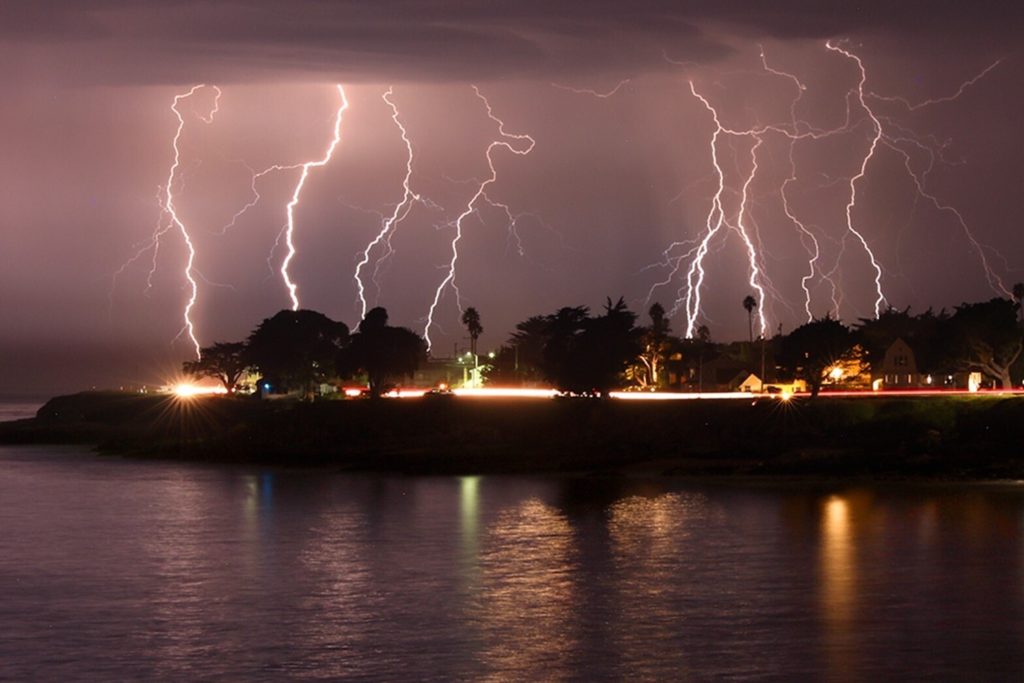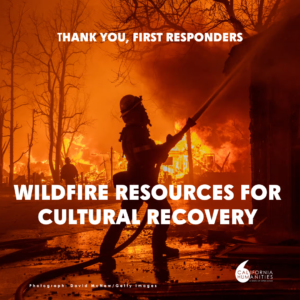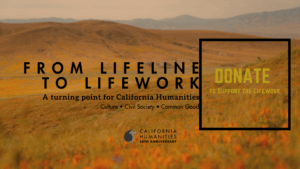“Fires can destroy things, but they can also reveal things that would have remained hidden.”– Martin Rizzo Martinez, State Parks Historian for the Santa Cruz region
WHAT FIRE REVEALS: STORIES FROM THE CZU AUGUST LIGHTNING COMPLEX FIRES, a new audio documentary from producers The Kitchen Sisters, supported through the California Documentary Project Grant, launched in August 2021 with an excerpt airing nationally on NPR’s Morning Edition and the release of the 40-minute podcast and video. Timed to coincide with the first anniversary of wildfires in the Santa Cruz Mountains that destroyed some 900 homes and 86,000 acres, the podcast features residents reflecting on what is lost and what is revealed by fire. In association with the podcast, The Santa Cruz Museum of Art & History (MAH) hosted “Out of the Ashes,” an exhibition of photographer Shmuel Thaler’s documentation of artifacts that survived the fires.
In this interview, Senior Program Officer John Lightfoot asks The Kitchen Sisters (Nikki Silva and Davia Nelson) to tell us more about their new audio documentary.
As longtime audio producers, The Kitchen Sisters have told stories from all over the world. This project, however, is more local for you. Can you describe your history with and connection to the region affected by the fires?
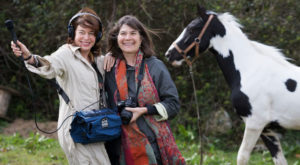
The Kitchen Sisters, Nikki Silva and Davia Nelson, met and began our audio careers in Santa Cruz with the dream of doing local oral histories about the fast community and fast disappearing lifestyles, rituals, and traditions in our region. We were doing a live weekly radio show on the local community station KUSP. With the help and encouragement of a grant from The California Council for the Humanities, we began producing local stories that ultimately aired on NPR’s Weekend Edition and All Things Considered—The Road Ranger, Tupperware, The Miss California Pageant, The Musical Saw Festival.
Over the years, our stories have become more national and international in scope, but the idea of community and local people telling their own stories has been a through-line. And we still have strong connections to the Santa Cruz region, where Nikki lives and worked for many years as the history curator of the Santa Cruz Museum of Art and History.
Following the 1989 Loma Prieta Earthquake, The Kitchen Sisters gathered more than 100 interviews chronicling the aftermath of the disaster for the museum, the city, and the historical record. When the 2020 CZU Lightning Complex fires raged through the Santa Cruz Mountains, we felt a similar need to chronicle how the community was dealing with this disaster. Shmuel Thaler, the photographer for the Santa Cruz Sentinel, contacted us with the idea of inviting people who had lost their homes to bring in objects found in the ashes to be photographed at the museum. He asked if we would record people’s experiences and the stories that the objects conjured.
It has been a powerful project. Once again, with the support and encouragement of California Humanities, these stories have been aired on NPR’s Morning Edition, KQED’s California Report Magazine, KSQD Santa Cruz, and made available to stations across the country through the Public Radio Exchange. We were also able to create a video featuring Shmuel Thaler’s incredible photographs and the voices and stories of the people we documented.
For someone unfamiliar with the area, please describe the community, character, and landscape of the Santa Cruz Mountains. Is there something unique about people who live (or lived) there?
Wow! Yes! The Santa Cruz Mountains is a rugged, unique, densely wooded, beautiful, wonderfully alive region, with many small communities and creative, independent, and diverse residents and characters. We interviewed a retired fireman who had worked on multiple wildfires throughout California, an artist from Uruguay and her five-year-old grandson, the manager of Pie Ranch Farm stand on Highway 1, a Wiccan witch who retired from her software designer job at Google where she worked developing Google Maps, a former highway patrolman, a Grateful Dead Head, the undocumented daughter of farmworkers who work and live on the North Coast, State Parks Rangers, members of the Amah Mutsun Land Stewardship Program who are working with State Parks clearing the land and conducting cultural and controlled burns in the region, and so many more.
Without giving too much away, can you share some of what the CZU fires revealed, both literally and figuratively? Are there two or three specific stories that particularly resonated with you?
We always say that stories beget stories, and the Amah Mutsun Land Stewardship story was one of the most meaningful and hopeful stories that emerged from our interviews. It wasn’t one we knew about or were expecting. When we visited the State Parks historian and archaeologist, we learned about the project they have been doing with the Amah Mutsun Tribal Band. Each week members of the tribe come to work on State Park Land. They do clearing, culturally and prescribed burning, plant native plants, and work with archaeologists and anthropologists from UCSC, Stanford, UC Berkeley, and other educational institutions. They are learning and reclaiming information about their almost forgotten history and land preservation mission and techniques. These Land Stewards come from Fresno, Madera, the Central Valley, and Sacramento each week to do this work then return to their homes on the weekend. They cannot afford to live here —the land of their ancestors. Right now, they stay in tents on Pie Ranch on the North Coast because the fire damaged the State Parks building on Cascade Ranch where they were housed. BUT the house didn’t burn. And the area that the Stewards have been tending in the Quiroste Valley area—that didn’t burn either. The fire went around it.
The story of Abigail, the teenage daughter of farmworkers who live in farmworkers’ housing on the North Coast, was also revealing. Abigail’s mother was working in the fields in Swanton and could see the smoke and embers falling. However, there were no warnings, and no one knew what was going on. Abigail was at home with her little sister and her brother, who has asthma. She’d heard about the fire but didn’t realize it was so close, and she didn’t see anything on social media. She finally went to the police department’s Twitter account, where she found an app showing what the oxygen levels were and how bad it could get. “I was just wondering, should we leave? What are we going to do? Where are we going to go?”
The police finally came to their door, and the family was terrified. “At least for me, I’m terrified of the police,” Abigail told us. “Like I know that they’re there to protect us, but from history, it’s scary. Being somebody of color, having the police in front of your door is like something you kind of never want to see.”
But the police were helpful, and the woman officer spoke Spanish. They encouraged the family to leave.
“But we had to let them know that we weren’t the only ones living in this area,” said Abigail. “We have neighbors living in RVs; that’s where all the workers live. They told us that they didn’t even know that we were here, and we have a mailbox, and the others don’t!”
Here’s a weird one. After the fire ripped through Big Basin, our oldest state park, burning 18,000 acres and destroying the iconic park buildings built by the WPA in the 1930s, workers went out to evaluate the old redwoods. Some were still smoldering from the fire. At the base of an old hollowed-out redwood tree stump, they noticed several pieces of silverware spilling out where the fire had burned down into the roots. They investigated further. Hidden away, deep in the forest in three burned-out stumps, they found hundreds of pieces of silverware, silver bowls, tureens, teapots, platters, candelabras.
“Clearly booty from somebody’s heist,” said Park Ranger Mark Hylkema as we stared in disbelief at the boxes and boxes of blackened silver now being cataloged and stored in the State Parks warehouse.
“I imagine that somebody, somewhere still has some treasure maps with the little X marks on these stumps,” said Martin Rizzo-Martinez, State Parks historian for the Santa Cruz region. “Fires can destroy things, but they can also reveal things that would have remained hidden.”
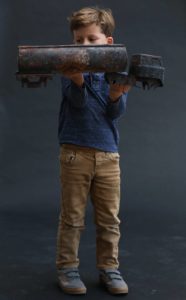
Here’s a final story: Jennifer Cordery is from Uruguay. She lived on Swanton Road in the woods with a creek nearby. She’s an artist, and the fire consumed everything—her paintings and drawings, all of her art supplies. She’d returned to the land a few times after the fire with her 5-year-old grandson, Rolo, whom she takes care of during the week. “He was excited to be a little archeologist and found things,” she said.
Salvaged from the ashes, Jennifer brought into the museum her flute and two bombias, “the things you use in Uruguay to drink maté.” One was hers, and one was Rolo’s.
“And this is an old truck of mine that we found in Swanton at Tata’s broken down house…” Rolo interjected as he showed us a large, charred metal toy.
When we asked Jennifer how she explained things to Rolo after the fire, she said, “I just told him, ‘you know, Swanton is burnt.’ The first thing he said to me was, ‘You know something that can’t burn? It’s the stories you told me.’ He said ‘and that can never burn.’”
PS: Here is an email we received from Jennifer after the CZU story aired on KQED’s California Report Magazine:
Hi Nikki, One of your listeners reached out to me after hearing about the fire- a very nice woman from San Leandro, an ex UCSC art student. She offered me a bunch of art materials she never used, as her life took a different path unrelated to art. Yesterday, she came to my house and brought me many things! She asked me to tell you that she is a huge, longtime fan of the Kitchen Sisters.
Thank you again for the show and the program about the fire. I took Rolo to the museum to see the show. He loved seeing his big photo! Lots of love to you. Jennifer
A year after the fires, is the community recovering, and has the project played a role in that recovery?
Yes. The project has resonated. The Museum of Art and History has opened an exhibition called Out of the Ashes which will be up for the next year featuring Shmuel Thaler’s photos and the audio and video we produced. The show has been very well attended and received. And we have received many responses from the people who participated in the project and others who lost their homes talking about how therapeutic it has been to talk about what happened as they work through the trauma of losing their homes.
We also did a zoom presentation where many participants met and shared their experiences and resources with one another.
And we are still at it, gathering interviews, photographs and giving presentations about the project. The Bonny Doon Fire Safe Council, a volunteer community group, has just invited us to present the project to their members, many of whom feel the fire’s story and the response to the fire have not been fully documented and investigated by official agencies. We hope to gather interviews for the historical record from this community, where many stayed to fight the fire and save their homes and neighborhoods.
Lastly, the Kitchen Sisters and California Humanities go way back. Can you tell us the story of how you first got to know us, back when we were still the California Council for the Humanities?
In our hearts, you will always be the California Council for the Humanities —that incredible organization that in 1980 gave us our first grant to produce Every Wrinkle Tells a Story, a series of oral radio histories documenting the Tri-County area —Santa Cruz, Monterey, and San Benito Counties. It was a one-to-one matching $24,000 grant, as we remember. We still laugh about that fundraising adventure—five, ten dollars at a time. But it worked and really got us out there in the community talking about the importance of documenting peoples’ stories. So thank you, California Humanities, a.k.a. CCH!
To learn more and listen to the podcast, visit the Kitchen Sisters’ website.
WHAT FIRE REVEALS was supported by California Humanities through the California Documentary Project grant program.

